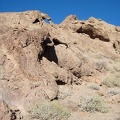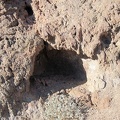44/79
Home / Mojave Preserve and Desert bikepacking trips / Fall 2010: Route 66 and Kelso Dunes Wilderness Bicycle Camping / Day 5: Day hike across Broadwell Dry Lake and to Broadwell Natural Arch, Bristol Mountains, Kelso Dunes Wilderness Area /
A few Rush milkweeds are flowering here right now (Asclepias subulata)
Thanks for the plant ID, Lee. I would not have guessed this is a milkweed. I also saw a few of these during my hike along the fan on the west side of the Bristol Mountains two days ago.

